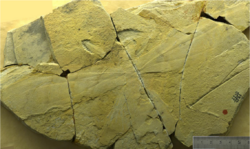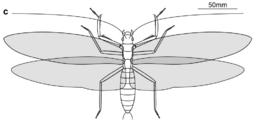Biology:Gigatitan
| Gigatitan | |
|---|---|

| |
| Fossil of G. vulgaris | |

| |
| Life reconstruction of G. vulgaris | |
| Scientific classification | |
| Domain: | Eukaryota |
| Kingdom: | Animalia |
| Phylum: | Arthropoda |
| Class: | Insecta |
| Order: | †Titanoptera |
| Clade: | †Gigatitanidae |
| Genus: | †Gigatitan Sharov, 1968 |
| Type species | |
| Gigatitan vulgaris Sharov, 1968
| |
| Species[1] | |
| |
Gigatitan is an extinct genus of titanopteran insect that lived in Kyrgyzstan during the Triassic period. The type species is G. vulgaris, described by Aleksandr Grigorevich Sharov in 1968.[2] Fossils of Gigatitan have been found in the Madygen Formation.[3] It is the type genus of the family Gigatitanidae, in which the closely related Nanotitan and Ootitan are also included.[2][4]
Description

Gigatitan was a large insect, type species, G. vulgaris is estimated to have wingspan up to 40 centimetres (16 in).[5] Although it had large wings, which hindwing area is close to modern large orthopteran Pseudophyllanax imperialis, body volume is estimated to be around 150% heavier than that species, suggesting Gigatitan was not able to fly, but probably able to glide.[1] In life, Gigatitan was a mantis-like predator, with forelegs that have similarly enlarged and bore spines for prey capture.[6] It had dark, transverse stripes on its wings, which is similar to modern diurnal mantis Blepharopsis mendica. Also, its wings were able to produce flashes which works only during day, and possibly it can substantially reduce predation from predators. These characters suggest that Gigatitan was a diurnal predator.[1] As seen in other titanopteran insects, there are prominent fluted regions on the forewings, suggesting that may used for stridulation, but unlike modern crickets or katydids, both males and females of Gigatitan had wings for stridulation.[1] The ovipositor of Gigatitan bore sharp cutting ridges. These were likely used to excise holes in plant matter for oviposition, similar to some modern Orthoptera.[7]
References
- ↑ 1.0 1.1 1.2 1.3 Schubnel, Thomas; Legendre, Frédéric; Roques, Patrick; Garrouste, Romain; Cornette, Raphaël; Perreau, Michel; Perreau, Naïl; Desutter-Grandcolas, Laure et al. (2021-07-08). "Sound vs. light: wing-based communication in Carboniferous insects" (in en). Communications Biology 4 (1): 794. doi:10.1038/s42003-021-02281-0. ISSN 2399-3642. PMID 34239029.
- ↑ 2.0 2.1 Béthoux, O. (2007). "Cladotypic Taxonomy Applied: Titanopterans are Orthopterans". Arthropod Systematics & Phylogeny 65 (2): 135–156. ISSN 1863-7221.
- ↑ Voigt, Sebastian; Spindler, Frederik; Fischer, Jan; Kogan, Ilja; Buchwitz, Michael (2007-09-26). "An extraordinary lake basin – the Madygen fossil lagerstaette (Middle to Upper Triassic, Kyrgyzstan, Central Asia)". Jahrestagung der Paläontologischen Gesellschaft 36. https://www.researchgate.net/publication/267979882.
- ↑ Gorochov, A.V. (2007). "The first representative of the suborder Mesotitanina from the Paleozoic and notes on the system and evolution of the order Titanoptera (Insecta: Polyneoptera)". Paleontological Journal 41 (6): 621–625. doi:10.1134/S0031030107060056. ISSN 1555-6174.
- ↑ Park, Tae-Yoon S.; Kim, Do-Yoon; Nam, Gi-Soo; Lee, Mirinae (2022-05-06). "A new titanopteran Magnatitan jongheoni n. gen. n. sp. from southwestern Korean Peninsula" (in en). Journal of Paleontology 96 (5): 1111–1118. doi:10.1017/jpa.2022.30. ISSN 0022-3360.
- ↑ Grimaldi, D. (2009). "Fossil Record". Encyclopedia of Insects (2nd ed.). Cambridge: Academic Press. pp. 396–403. doi:10.1016/B978-0-12-374144-8.00114-4. ISBN 978-0-12-374144-8. http://www.sciencedirect.com/science/book/9780123741448.
- ↑ Bethoux, O.; Galtier, J.; Nel, A. (2007). "Earliest Evidence of Insect Endophytic Oviposition". PALAIOS 19 (4): 408–413. doi:10.1669/0883-1351(2004)019<0408:EEOIEO>2.0.CO;2.
Wikidata ☰ Q48998426 entry
 |

